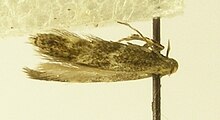Elachista canapennella
Appearance
| Elachista canapennella | |
|---|---|

| |
| Elachista canapennella | |

| |
| Scientific classification | |
| Kingdom: | |
| Phylum: | |
| Class: | |
| Order: | |
| Family: | |
| Genus: | |
| Species: | E. canapennella
|
| Binomial name | |
| Elachista canapennella (Hübner, 1813)
| |
| Synonyms | |
|
List
| |
Elachista canapennella is a moth of the family Elachistidae found in Europe.
Description
The wingspan is 8–10 millimetres (0.31–0.39 in).[1] Adults are on wing from April to June and from July to September. There are two generations per year.
The larvae feed on creeping bent (Agrostis stolonifera), false oat-grass (Arrhenatherum elatius), Avenula pubescens, tufted hairgrass (Deschampsia cespitosa), fescue (Festuca species), creeping soft grass (Holcus mollis) and meadow-grass (Poa). They mine the leaves of their host. The pupation takes place outside the mine.[2]
Distribution
It is found from Fennoscandia and northern Russia to the Pyrenees, Italy and Romania and from Ireland to central Russia.[2]
References
- ^ "Elachista canapennella". UK Moths. Retrieved March 8, 2010.
- ^ a b Ellis, W N. "Elachista canapennella (Hübner, 1813) little dwarf". Plant Parasites of Europe. Retrieved 26 March 2020.
External links
